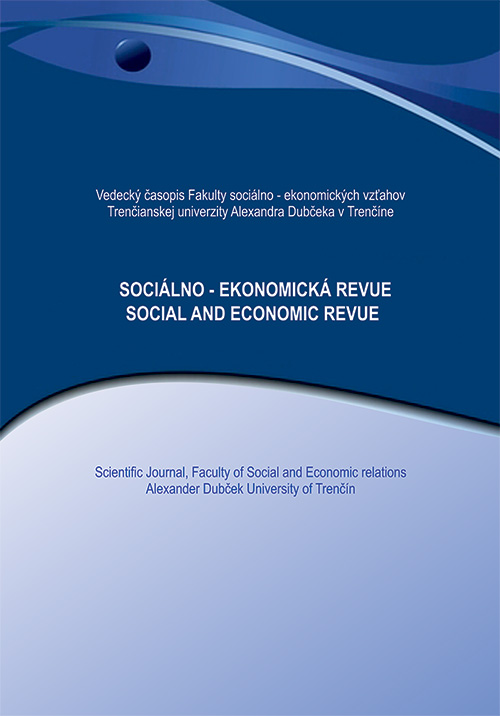THE HUMAN RESOURCES USING EFFICIENCY IN POLISH PUBLIC HOSPITALS - SPATIO-TEMPORAL ANALYSIS
Within many health care systems worldwide, increased attention is being focused on human resources management (HRM). Specifically, human resources are one of three principle health system inputs, with the other two major inputs: physical capital and consumables. Human resources, when pertaining to health care, can be defined as the different kinds of clinical and non-clinical staff responsible for public and individual health intervention. As arguably the most important of the health system inputs, the performance and the benefits the system can deliver, depend largely upon the knowledge, skills and motivation of those individuals responsible for delivering health services. The article is focused on an identification of spatio-temporal diversification of human resources using efficiency in Polish public hospitals. The data collection was achieved through secondary sources such as The Ministry of Health in Poland. The main human resources issues and questions, along with the analysis of the human resources impact on the health care system was examined, as well as the identification of the trends in health sector reform. These trends include efficiency, equity and quality objectives.
Release: 2017/4 Pages: 6-14 JEL classification: O15, D61, D60
DOI:
Keywords: efficiency, public hospital, human resources
Section: HUMAN RESOURCES AND PERSONNEL MANAGEMENT
Contacts:
Agnieszka Krawczyk-Sołtys, PhD,
Research Center for Management in Health Care,
Faculty of Economics,
Opole University,
Ozimska 46a, 45-058 Opole,
Poland
akrawczyk.soltys@uni.opole.pl
Agnieszka Tłuczak, PhD,
Research Center for Management in Health Care,
Faculty of Economics,
Opole University,
Ozimska 46a, 45-058 Opole,
Poland
atluczak@uni.opole.pl
Literature:
Baliszewski T. (2013). Polska służba zdrowia efektywniejsza od amerykańskiej i niemieckiej. Tak wynika z rankingu "Bloomberga" [acc.: 2017-02-27].Avilable at: http://natemat.pl/73109,polska-sluzba-zdrowia-efektywniejsza-od-amerykanskiej-i-niemieckiej-tak-twierdzi-bloomberg-com
Barney J.B. (1991). Firm Resources and Sustained Competitive Advantage, Journal of Management, no. 1, 99-120.
Bielski M.(1996). Organizacje. Istota. Struktura. Procesy, Wydawnictwo Uniwersytetu Łódzkiego, Łódź 1996.
Biorn E., Hagen T. P., Iversen T., Magnussen J. (2003). The Effect of Activity-Based Financing on Hospital Efficiency: A Panel Data Analysis of DEA Efficiency Scores 1992–2000. Health Care Management Science, 6 (4), 271–283.
Blaik P. (2010). Logistyka. Koncepcja zintegrowanego zarządzania, PWE, Warszawa, 411
Bloor K., Maynard A. (2003). Planning human resources in health care: Towards an economic approach. An international comparative review, Canadian Health Services Research Foundation, Ottawa.
Cook W. D., Liang L., Zha Y., Zhu J. (2009). A modified super-efficiency DEA model for infeasibility. Journal of the Operational Research Society, 60 (2), 276–281.
Cooper W. W., Seiford L. M., Tone K. (2000). The Basic CCR model. Cooper W. W., Seiford L. M., Tone K. (ed.): Data envelopment analysis: a comprehensive text with models, applications, references and DEA-solver software, Kluwer, Boston, 21 – 39.
Data for Efficiency: A tool for Assessing Health Systems’ Resource Use Efficiency. Health Finance & Governance Project, Abt Associates Inc., Bethesda, MD 2013.
Diez –Ticio A., Mancebon M.-J. (2002). The efficiency of the Spanish police service: an application of the multiactivity DEA model. Applied Economics. 34 (3), 51-62.
Dubas K. (2011). Problematyka efektywności w ochronie zdrowia- znaczenie i metody pomiaru. Problemy Zarządzania, Vol. 9, nr 3, 102-125.
Edirisinghe N. C. P., Zhang X. (2007). Generalized DEA model of fundamental analysis and its application to portfolio optimization. Journal of Banking & Finance, 31 (11), 3311–3335.
Elarabi H.M., Johari F. (2014). The Impact Of Human Resources Management On Healthcare Quality, Asian Journal Of Management Sciences & Education, 3 (1), 13-22.
Ferrier G. D. , Rosko M. D., Valdmanis V. G. (2006). Analysis of uncompensated hospital care using a DEA model of output congestion. Health Care Manage Science, 9, 181–188.
Heredia-Ortiz E.(2013). Data for Efficiency: A tool for Assessing Health Systems’ Resource Use Efficiency. Health Finance & Governance Project, Abt Associates Inc., Bethesda.
Golinowska S. (Ed.) (2012). Zarys Systemu Ochrony Zdrowia. Polska 2012, NFZ, Warszawa.
Hofer C.W., Schendel D.(1978). Strategy Formulation: Analytical Concepts, West Pub. Co., St. Paul.
Harris C., Cortvriend, P., Hyde, P. (2007). Human resource management and performance in health care organizations, Journal of Health Organization and Management, 21(4/5), 448-459.
Hofmarcher M. M., Paterson I., Riedel M. (2002). Measuring Hospital Efficiency in Austria – A DEA Approach. Health Care Management Science, 5 (1), 7–14.
Jacobs R. (2001). Alternative Methods to Examine Hospital Efficiency: Data Envelopment Analysis and Stochastic Frontier Analysis. Health Care Management Science, 4 (2), 103–115.
Kane R., Lum, T., Cutler, L., Degenholtz, H., Yu, T. (2007). Resident outcomes in small house nursing homes: A longitudinal evaluation of the initial Green House program. Journal of Geriatrics Society, 55(6), 832-839.
Keating, M. (2011). Managing professionals: exploring the role of the hospital HR function. Journal of Health Organization and Management, 25(6), 677-692.
Krawczyk-Sołtys A. (2013). Zarządzanie wiedzą w szpitalach publicznych. Identyfikacja poziomu i kierunki doskonalenia, Studia i Monografie nr 485, Wydawnictwo Uniwersytetu Opolskiego, Opole.
Linna M. (1998). Measuring hospital cost efficiency with panel data models. Health Economics, 7 (5), 415–427.
Manheim L. M., Feinglass J., Shortell S. M., Hughes E. F. X. (1992). Regional Variation in Medicare Hospital Mortality. Inquiry, 29 (1), 55-66.
Nayar P., Ozcan Y.A. (2008). Data Envelopment Analysis Comparison of Hospital Efficiency and Quality. Journal of Medical Systems, 32 (3), 193–199.
Oliver C. (1997). Sustainable Competitive Advantage: Combining Institutional and Resource-Based Views, Strategic Management Journal, vol. 18, 697-713.
O’Neill L., Rauner M., Heidnberger K., Kraus M. (2008). A cross-national comparison and taxonomy of DEA-based hospital efficiency studies. Socio-Economic Planning Sciences, 42 (3), 158–189.
Penrose E.T.(1959). The Theory of the Growth of the Firm, Willey, New York.
Sherman D. H. (1984). Hospital Efficiency Measurement and Evaluation: Empirical Test of a New Technique. Medical Care,. 22 (10), 922-938.
Wen M., Li H.(2009). Fuzzy data envelopment analysis (DEA): Model and ranking method. Journal of Computational and Applied Mathematics, 223 (2), 872–878.
Yang Y., Ma B., Koike M. (2000)., Efficiency-measuring DEA model for production system with independent subsystems. Journal of the Operations Research Society of Japan, 43 (3), 343 – 354.
Yu M.-M., Lin E. T. J. (2008). Efficiency and effectiveness in railway performance using a multi-activity network DEA model. Omega, 36 (6), 1005–1017.
Zairi M. (1998). Building human resources capability in health care: a global analysis of best practice – part I. Health Manpower Management, 24(2-3), 88-99.


